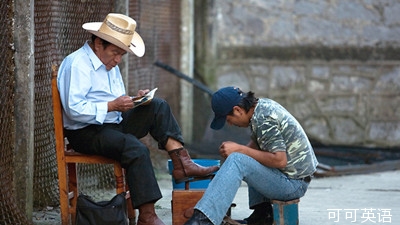財經商業
Defining class in Mexico
墨西哥階層劃定
Middle worth
中產階級的價值
Politicians and statisticians hunt for the middle class
政治家和統計員們尋找中產階級
IN THE hallowed name of the middle class, Mexico's politicians have been doing a lot of huffing and puffing lately.
在中產階級的神圣名義下,墨西哥的政治家最近一直在進行大量憤怒抨擊。
The source of their indignation is the president's plan to raise income tax on annual salaries over 500,000 pesos and impose value-added tax on private schooling and mortgage payments.
他們憤怒的起因是總統對年工資收入超過500,000比索的人提高所得稅和對私人學校和抵押貸款征收增值稅的計劃。
That, the people's representatives complain, would beat the stuffing out of ordinary, hard-working families, so they plan to spare them the tax on schooling and housing.
這樣的話,人民的代表們抱怨道,會使普通的,努力工作的家庭一蹶不振,所以他們打算幫他們在教育和房貸方面減輕稅務負擔。
If only the middle class were so lucky.
如果中產階級有這么幸運的話。
 According to measurements by the national statistics institute, most of its members earn nowhere near the 500,000-peso threshold, let alone send their children to private school or pay mortgages.
According to measurements by the national statistics institute, most of its members earn nowhere near the 500,000-peso threshold, let alone send their children to private school or pay mortgages.
根據國家統計局的測量,它的大部分成員每年賺的遠遠不到500,000門檻,更不用說送他們的孩子去私人學校或者支付抵押貸款了。
Defining the middle class in Mexico has become a subject of fierce debate since two pundits, Luis de la Calle and Luis Rubio, published a book last year called Mexico: A Middle Class Society.
明確在墨西哥的中產階級成為激烈辯論的一個話題,自從兩個學者,Luis de Ia Calle and Luis Rubio,去年出版了一本名為墨西哥:一個中產階級社會。
Poor No More, Developed Not Yet.
不再貧窮,尚未發達。
It claimed that more than half of Mexico's population had joined the bourgeoisie.
它聲稱超過一半的墨西哥人口已經成為了資產階級。
INEGI's statisticians were sceptical, partly because the book used access to technology as a measure of social status.
國家統計局的統計員們對此持懷疑態度,部分是因為這本書以接觸到現代科技作為社會地位的估量措施。
So the institute set out to develop a new definition, not based on any preconceptions of what a middle-class household should look like.
所以這個機構著手發展一個新的定義,不是基于任何對中產階級的房子應該是什么樣子的先入之見。
First, INEGI looked at spending rather than income.
首先,國家統計局把視線投向花費而不是收入。
It reckoned spending is less likely to be underreported in its household surveys, and may also incorporate information about savings and expected future earnings.
它認為花費更不可能在家庭調查中被低估,并且它可能還包含著儲蓄和預期未來收入的信息。
Household spending, however, can be a slippery gauge of social status.
不過家庭花費可能是社會地位一個不容易捉摸的標準。
It may rise in families with many children and fall among the elderly.
它可能在孩子很多的家庭上升和老年人下降。
It can be distorted by one-off events, such as illness or funerals.
它可能被一次性的事件曲解,例如疾病或者葬禮。
So INEGI focused on 17 categories of spending that are recurrent and to some extent discretionary, such as the number of rooms in a home, or outlays on chicken, education or haircuts.
所以國家統計局集中關注17種周期性的并且在某種程度上具有任意性的花費,例如家里的房間數,或者在雞肉上的花費,教育或者美發。
This allowed INEGI to sort households into seven groups.
這樣使國家統計局將家庭分為七個種類。
It then analysed these using more typical variables, such as income per head, education, age, family size and type of work.
它接著使用更多的典型變量來分析這些家庭,如每個人頭的收入,教育,年齡,家庭規模和工作類型。
The combination of the two forms of analysis allowed it to establish levels of income at which consumption patterns tend to change.
兩種分析形式的結合讓它能確立收入水平,在這種水平下消費模式有變化的趨勢。
INEGI concluded that Mexico's middle class, at 39% of the population, was much smaller than Messrs De la Calle and Rubio had estimated, but in keeping with the estimates of institutions like the World Bank.
國家統計局總結墨西哥的中產階級,占人口的39%,遠遠小于兩位學者曾經估計的,而與像世界銀行之類的機構估計一致。
Moreover, middle-class Mexicans are not nearly as affluent as the politicians imagine, even if they are a lot more secure than those beneath them. Annual incomes reach only about 120,000 pesos—less than a quarter of the sum needed to enter the top tax bracket.
更進一步,中產墨西哥人不是如同政治家們想象的那么富裕的,盡管他們要遠遠比那些在他們之下的人要安全的多。
Only 29% of the middle class have children at private school, and just 9% pay mortgages.
年度收入僅僅為120,000比索—少于進入最高稅級所需要數額的四分之一。僅僅有29%的中產階級的孩子在私人學校上學,以及9%在支付房貸。
Politicians, in contrast, earn upwards of 1m pesos a year, which makes them almost ten times wealthier than a middle-class person as defined by INEGI.
政治家們,相反,每年賺超過1百萬比索,這讓他們幾乎比一個被國家統計局定義為中產階級的人富有十倍。
No wonder they are out of touch.
難怪他們與現實脫節。
 According to measurements by the national statistics institute, most of its members earn nowhere near the 500,000-peso threshold, let alone send their children to private school or pay mortgages.
According to measurements by the national statistics institute, most of its members earn nowhere near the 500,000-peso threshold, let alone send their children to private school or pay mortgages.
 According to measurements by the national statistics institute, most of its members earn nowhere near the 500,000-peso threshold, let alone send their children to private school or pay mortgages.
According to measurements by the national statistics institute, most of its members earn nowhere near the 500,000-peso threshold, let alone send their children to private school or pay mortgages.